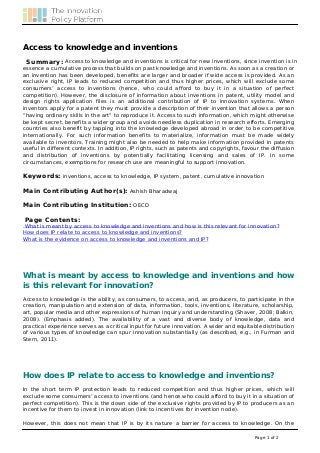
Access to Knowledge and Inventions - Innovation Policy Platform (OECD)
- 1. Access to knowledge and inventions Summary: Access to knowledge and inventions is critical for new inventions, since invention is in essence a cumulative process that builds on past knowledge and inventions. As soon as a creation or an invention has been developed, benefits are larger and broader if wide access is provided. As an exclusive right, IP leads to reduced competition and thus higher prices, which will exclude some consumers’ access to inventions (hence, who could afford to buy it in a situation of perfect competition). However, the disclosure of information about inventions in patent, utility model and design rights application files is an additional contribution of IP to innovation systems. When inventors apply for a patent they must provide a description of their invention that allows a person “having ordinary skills in the art” to reproduce it. Access to such information, which might otherwise be kept secret, benefits a wider group and avoids needless duplication in research efforts. Emerging countries also benefit by tapping into the knowledge developed abroad in order to be competitive internationally. For such information benefits to materialize, information must be made widely available to inventors. Training might also be needed to help make information provided in patents useful in different contexts. In addition, IP rights, such as patents and copyrights, favour the diffusion and distribution of inventions by potentially facilitating licensing and sales of IP. In some circumstances, exemptions for research use are meaningful to support innovation. Keywords: inventions, access to knowledge, IP system, patent, cumulative innovation Main Contributing Author(s): Ashish Bharadwaj Main Contributing Institution: OECD Page Contents: What is meant by access to knowledge and inventions and how is this relevant for innovation? How does IP relate to access to knowledge and inventions? What is the evidence on access to knowledge and inventions and IP? What is meant by access to knowledge and inventions and how is this relevant for innovation? Access to knowledge is the ability, as consumers, to access, and, as producers, to participate in the creation, manipulation and extension of data, information, tools, inventions, literature, scholarship, art, popular media and other expressions of human inquiry and understanding (Shaver, 2008; Balkin, 2008). (Emphasis added). The availability of a vast and diverse body of knowledge, data and practical experience serves as a critical input for future innovation. A wider and equitable distribution of various types of knowledge can spur innovation substantially (as described, e.g., in Furman and Stern, 2011). How does IP relate to access to knowledge and inventions? In the short term IP protection leads to reduced competition and thus higher prices, which will exclude some consumers’ access to inventions (and hence who could afford to buy it in a situation of perfect competition). This is the down side of the exclusive rights provided by IP to producers as an incentive for them to invest in innovation (link to incentives for invention node). However, this does not mean that IP is by its nature a barrier for access to knowledge. On the Page 1 of 2
- 2. contrary, a major role of IP offices is to collect, publish and disseminate the description of inventions protected by patents, utility models and design rights. Patent information (contained in filed and published patent applications in many countries) is an important source of valuable technical and legal information about inventions. Similarly, design rights and utility model applications provide relevant information. This information can serve various user groups (researchers, scientists, business managers, economists and policy makers), thus playing a fundamental role in the checksand-balance mechanism of the patent system (WIPO, 2009). Such information might in the absence of IP be kept secret by inventors out of fear others might appropriate their inventions. However, for the IP system to effectively provide access to knowledge, several conditions must be in place: first, applicants must be effectively requested to disclose information on their inventions that can be understood by a person skilled in the art. Second, IP offices must be tasked to effectively provide access to such information, since it is often not in the interest of the inventor to do so. Third, training is needed for firms to be able to use the information and build on it to support innovation. Licensing arrangements are another way how IP can facilitate access to knowledge and inventions (see Licensing and markets for IP). What is the evidence on access to knowledge and inventions and IP? There exist diverse international databases with global patent information, like the espacenet (maintained by EPO) or Patent Scope, from the WIPO. A new online Global Patent Search Network (GPSN) was launched in July 2013 by the U.S. Patent and Trademark Office (USPTO), enabling users to access Chinese patent documentation (including full document images) to conduct prior art searches in machine-translated English or Chinese. References Balkin, J. (2008), “Foreword”, in Access to Knowledge in Egypt: New Research on Intellectual Property, Innovation and Developmen”, N. Rizk and L. Shaver (eds.), Bloomsbury Academic, London. Furman, J. and S. Stern (2011), “Climbing atop the shoulders of giants: The impact of institutions on cumulative research”, American Economic Review, Vol. 101, pp. 1933–63. Layne-Farrar, A. and J. Lerner (2011), “To join or not to join: Examining patent pool participation and rent sharing rules”, International Journal of Industrial Organization, Vol. 29, pp. 294–303. WIPO (2009), “Dissemination of patent information”, Standing Committee on the Law of Patents, Thirteenth session of the World Intellectual Property Organization, WIPO, Geneva. http://www.wipo.int/edocs/mdocs/scp/en/scp_13/scp_13_5.pdf Source URL: https://innovationpolicyplatform.org/content/access-knowledge-and-inventions Page 2 of 2 Powered by TCPDF (www.tcpdf.org)
